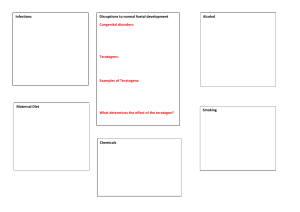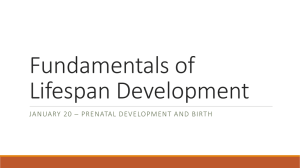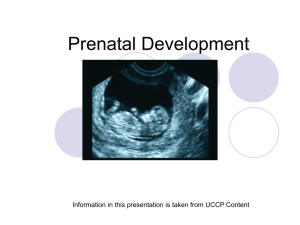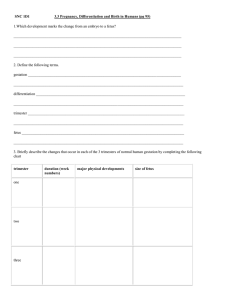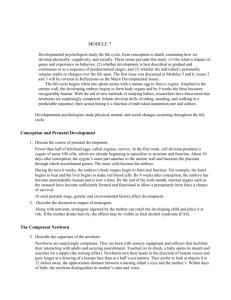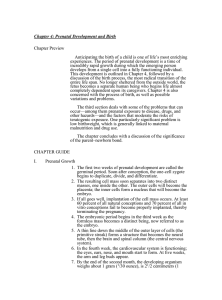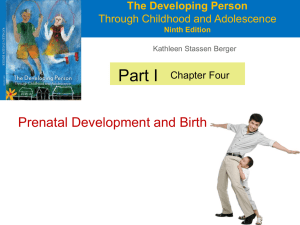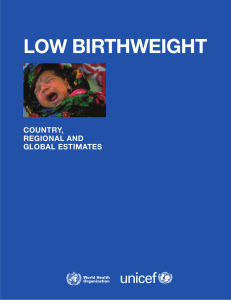Human Growth and Development Chapter Four
advertisement
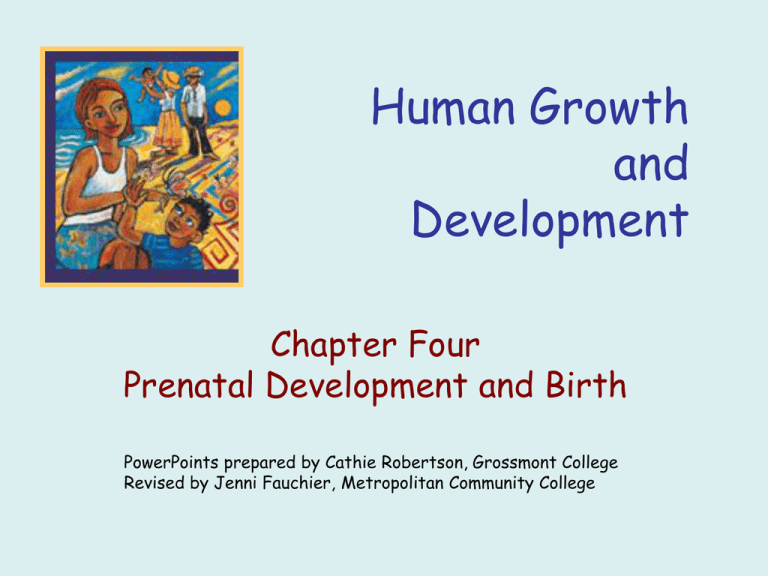
Human Growth and Development Chapter Four Prenatal Development and Birth PowerPoints prepared by Cathie Robertson, Grossmont College Revised by Jenni Fauchier, Metropolitan Community College From Zygote to Newborn • Germinal period—first 14 days • Embryonic period—3rd through 8th weeks • Fetal period—9th week through birth Process of Conception Germinal: The First 14 Days • Zygote divides and keep dividing (at least though 3rd doubling they are the same) • At this stage (8 cells) differentiation begins - early “stem” cells take on distinct characteristics - they gravitate to locations, foreshadowing the type of cells they will become Germinal: The First 14 Days, cont. • At about a week after conception the multiplying cells separate into two masses - outer layer forms a shell (later the placenta) and the inner cells from a nucleus (later the embryo) - first task of out cells to achieve implantation— embed themselves into the nuturant environment of the uterus • 60% of all natural conceptions fail to implant; 70% of in vitro procedures fail to implant Embryo: From the Third to the Eighth Week • First sign of human structure: thin line down the middle (22 days) that becomes the neural tube, which eventually forms the central nervous system, including brain and spinal column – fourth week • head begins to take shape • heart begins with a miniscule blood vessel that begins to pulsate Embryo: From the Third to the Eighth Week, cont. – fifth week • arm and leg buds appear • tail-like appendage extends from the spine – eighth week • embryo weighs 1 gram and is 1 inch long • head more rounded; face formed • all basic organs and body parts (but for sex) present – 20% of all embryos spontaneously abort now Fetus: From the Ninth Week Until Birth • Called a fetus from 9th week on Third Month • Sex organs take shape (Y cell sends signal to male sex organs; for females, no signal occurs) - genital organs fully shaped by 12th week • All body parts present • Fetus can move every part of body • Fetus weighs 3 ounces and is 3 inches long Middle Three Months: Preparing to Survive • Heartbeat stronger • Digestive and excretory systems develop more fully • Impressive brain growth (6X in size and responsive) - new neurons develop (neurogenesis) - synapses—connections between neurons (synaptogenesis) Middle Three Months: Preparing to Survive, cont. • Age of viability—age at which preterm baby can possibly survive (22 weeks) - 26 weeks survival rate about 50% . brain maturation critical to viability . weight critical to viability - 28 weeks survival rate about 95% Fetal Brain Maturation Final Three Months— Viability to Full Term • Maturation of the respiratory and cardiovascular systems -critical difference • Gains weight—4.5 lbs. in last 10 weeks Risk Reduction • Despite complexity, most babies are born healthy • Most hazards are avoidable • Teratology—study of birth defects – teratogens—broad range of substances that can cause environmental insults that may cause prenatal abnormalities or later learning abilities Determining Risk • Risk analysis—weighing of factors that affect likelihood of teratogen causing harm Timing of Exposure • Critical period—in prenatal development, the time when a particular organ or other body part is most susceptible to teratogenic damage -entire embryonic period is critical Amount of Exposure • Dose and/or frequency • Threshold effect—teratogen relatively harmless until exposure reaches a certain level Amount of Exposure, cont. • Interaction effect—risk of harm increases if exposure to teratogen occurs at the same time as exposure to another teratogen or risk Genetic Vulnerability • Genetic susceptibilities: product of genes combined with stress • Folic-acid deficiency may cause neural- tube defects - occurs most commonly in certain ethnic groups and less often in others • Males are more genetically vulnerable Specific Teratogens • No way to predict risk on an individual basis • Research has shown possible effects of most common and damaging teratogens • AIDS and alcohol extremely damaging – pregnant women with AIDS transmit it to their newborns; high doses of alcohol cause FAS; alcohol + drug use increase risk to developing organism Low Birthweight • Low Birthweight (LBW) – less than 5 1/2 lbs. • grows too slowly or weighs less than normal • more common than 10 years ago • second most common cause of neonatal death • Preterm – birth occurs 3 or more weeks before standard 38 weeks Low Birthweight, cont. • Small for Gestational Age (SGA) – maternal illness – maternal behavior • cigarette smoking (25% of SGA births) – maternal malnutrition • poorly nourished before and during pregnancy • underweight, undereating, and smoking tend to occur together Low Birthweight, cont. • Factors that affect normal prenatal growth – quality of medical care, education, social support, and cultural practices The Birth Process • Hormones in mother’s brain signals process • Contractions begin: strong and regular at 10 minutes apart – average labor for first births is 8 hours The Birth Process The Newborn’s First Minutes • Assessment—Apgar scale – five factors, 2 points each • heart rate • breathing • color • muscle tone • reflexes – score of 7 or better: normal – score under 7: needs help breathing – score under 4: needs urgent critical care Variations • Parents Reaction – preparation for birth, physical and emotional support, position and size of fetus, and practices of mother’s culture • Medical Attention – birth in every developed nation has medical attention – 22% of births in U.S. are cesarean section • removal of fetus via incisions in mother’s abdomen and uterus – is medical intervention always necessary? Birth Complications • Cerebral Palsy—brain damage causing difficulties in muscle control, possibly affecting speech or other body movements • Anoxia—lack of oxygen that, if prolonged, can cause brain damage or death First Intensive Care . . . Then Home • At the Hospital – many hospitals provide regular massage and soothing stimulation; ideally, parents share in caregiving • At Home – complications, e.g., minor medical crises – cognitive difficulties may emerge, but high-risk infants can develop normally Mothers, Fathers and a Good Start • Strong family support (familia) • Fathers play a crucial role – may help wives abstain from drugs or alcohol – can reduce maternal stress • Parental alliance—commitment by both parents to cooperate in raising child – helps alleviate postpartum depression Mothers, Fathers and a Good Start, cont. • Parent-infant bond—strong, loving connection that forms as parents hold, examine, and feed their newborn – immediate contact not needed for this to occur
